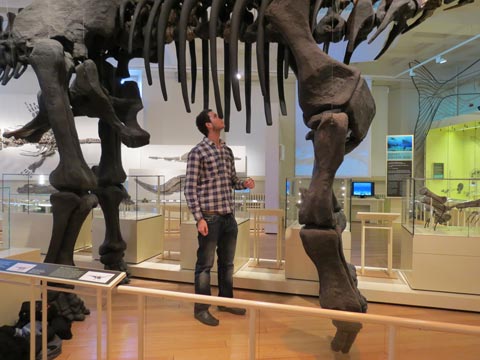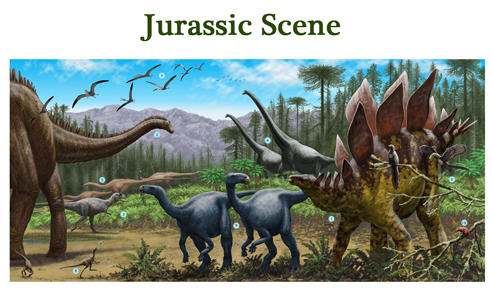New Research Examines the Diets of Giant Dinosaurs
How many plants would a ten tonne Diplodocus need to eat to keep it happy and healthy? For that matter, what about one of its larger cousins such as the macronarian Camarasaurus that tipped the scales at an estimated twenty tonnes? If you had a pet Dreadnoughtus (D. schrani), a long-necked, herbivorous dinosaur that was heavier than a dozen African elephants, how much food would you need to feed it each day?
Super-sized Sauropods and Their Super-sized Digestive Tracts

Picture credit: Dean Lomax
Palaeontologists have puzzled over the dietary requirements of these super-sized animals for many years. One of the theories put forward to explain the huge size of sauropods is that they needed to grow big so that they could carry around their vast digestive tracts that were needed to process the huge volumes of plant matter required to provide them with enough energy to do what dinosaurs needed to do.
Sauropoda body mass becomes a sort of self-fulfilling prophecy. You grow up fast and grow big to avoid predation, so you require a lot food to sustain your body, the bigger you get the more food you need to keep you going, the larger the stomach, especially as your teeth don’t play any role in helping to break up tough stems and foliage.
A Novel Approach
A team of scientists, including researchers from Leeds University, Nottingham University and the University of Göttingen (Germany), have conducted a novel piece of research so that the dietary needs of the largest terrestrial vertebrates can be better understood. The team grew their own dinosaur food in atmospheric conditions that replicated the environment of the Late Jurassic. Writing in the journal “Palaeontology”, the research team report on an experiment in which they grew typical plants that would have played a role in the diet of giant, herbivorous dinosaurs, ferns, horsetails, monkey puzzle trees and ginkgos.
The Ancient Ginkgo (Maidenhair) Tree – Dinosaur Food Assessed in this Plant Growth Experiment

Picture credit: Everything Dinosaur
Plants of the Jurassic Had a Low Nutritional Value
It had been thought that plants growing in an atmosphere with a high amounts of carbon dioxide had low nutritional value. As a result, herbivorous dinosaurs had to consume vast quantities of plant material in order to obtain enough energy to sustain themselves.
A new experimental approach led by Dr Fiona Gill (School of Earth & Environment, Leeds University), has demonstrated that this may not be the case. To explore the nutrition of a typical sauropod’s diet, a range of plants were chosen. Plants representing the understory community, such as a fern (Polypodium vulgare), a type of horsetail (Equisetum hyemale) as well as Ranunculus acris, a member of the buttercup family to represent an early Cretaceous angiosperm (flowering plant), were selected. Plants representing the forest canopy included the Ginkgo (G. biloba), Araucaria araucana, the monkey puzzle tree and a type of redwood conifer (Metasequoia glyptostroboides).
A Sauropod Stomach Study
The atmosphere was controlled as the plants were grown in walk-in growth chambers and the carbon dioxide concentrations were selected to represent a range of recent estimated CO2 values for the Mesozoic. Although we are seeing a rise in atmospheric amounts of carbon dioxide today, it has been estimated that during the Age of Dinosaurs there was considerably more CO2 in the atmosphere. By simulating prehistoric atmospheres, the research team could then cut leaves from the plants and test their nutritional value. The understory plants were exposed to a Mesozoic climate for three months, the slower growing plants representing the canopy were give six months in the Mesozoic atmospheric conditions.
The Researchers Set Out to Create a Growing Room Atmosphere that Replicated the Conditions of the Mesozoic

An Artificial Sauropod Stomach
An artificial fermentation system was used to simulate digestion of the plant leaves in the sauropods’ enormous stomachs. This permitted the research team to calculate the leaves’ nutritional value. The results showed many of the plants had significantly higher energy and nutrient levels than previously believed.
The scientists concluded that these megaherbivores would have needed to consume much less plant material per day than previously thought. Dinosaur numbers may not have been as constrained by the amount of plant food available. Ecosystems could have potentially supported a much bigger dinosaur population density. This might go some way to helping to explain the presence of lots of megaherbivores, including several different genera of sauropod present in the Upper Jurassic Morrison Formation of the United States.
Lead author Dr Gill, explained:
“The climate was very different in the Mesozoic Era, when the huge Brachiosaurus and Diplodocus lived with possibly much higher carbon dioxide levels. There has been the assumption that as plants grow faster and/or bigger under higher CO2 levels, their nutritional value decreases. Our results show this isn’t the case for all plant species.”
Higher CO2 Levels
Having modelled the effect of different food metabolisable energy (ME), contents in digested plants and plotted this against estimated energy requirements for different sized sauropods, the scientists concluded that instead of having to consume over a hundred kilograms of plants per day much smaller quantities would be required. For example, a 10 tonne Diplodocus with an assumed energy requirement of 280 kJ of metabolisable energy per kilogram of body weight per day, feeding exclusively on ferns would need to eat 33.2 kg per day. If it dined exclusively on horsetails it would need to eat 23.8 kilograms per day. An elephant, although smaller, as an endothermic mammal has a much greater energy requirement and would need to consume around 40 kilograms of plant material to sustain it.
An African Elephant Compared to a Diplodocid

Picture credit: Everything Dinosaur
Studying Dinosaur Diets
Dr Gill stated:
“The large body size of sauropods at that time would suggest they needed huge quantities of energy to sustain them. When the available food source has higher nutrient and energy levels it means less food needs to be consumed to provide sufficient energy, which in turn can affect population size and density. Our research doesn’t give the whole picture of dinosaur diet or cover the breadth of the plants that existed at this time, but a clearer understanding of how the dinosaurs ate can help scientists understand how they lived.”
This research is not limited to the Dinosauria, the same methodology can be utilised to model the atmospheric conditions at other points in geological deep time, to assess the nutritional requirements and feeding habits of long extinct, Miocene and Oligocene mammals for example.
The scientific paper: “Diets of Giants: the Nutritional Value of Sauropod Diet during the Mesozoic” by Fiona L. Gill, Jürgen Hummel, A. Reza Sharifi, Alexandra P. Lee, and Barry H. Lomax published in Palaeontology, the journal of the Palaeontological Association.
Visit the Everything Dinosaur website: Everything Dinosaur.






great, this helped me with my school work